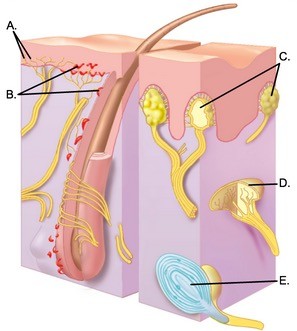In the body, inorganic compounds
A) can serve as buffers.
B) can make up proteins.
C) can make up lipids.
D) are structural components of cells.
E) are all very large.
Answer: A
You might also like to view...
During the resistance phase of the general adaptation syndrome (GAS),
A) lipid reserves are mobilized. B) proteins are conserved. C) blood glucose levels fall drastically. D) levels of growth hormone decrease. E) levels of insulin decrease.
Which region of the digestive tract moves material by peristalsis, haustral churning, and mass movement?
A. Large intestine B. Small intestine C. Stomach D. Esophagus E. Pharynx
Identify the submandibular gland in the figure
A) A B) B C) C D) D E) E
 The diagram illustrates sensory receptors in the skin. What structure does "D" represent?
The diagram illustrates sensory receptors in the skin. What structure does "D" represent?
A. Pacinian corpuscle B. Merkel disks C. Free nerve endings D. Meissner corpuscles E. Ruffini end organ